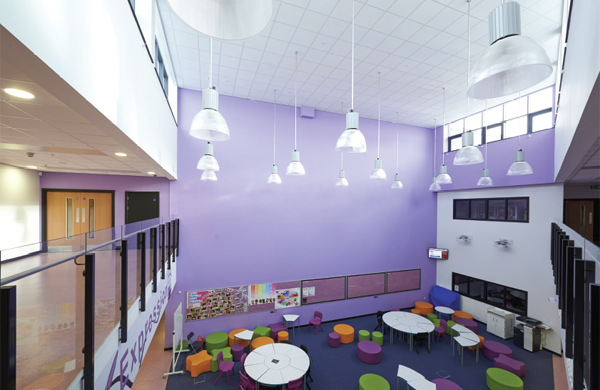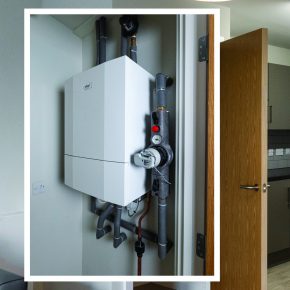
Painting the backdrop for a great education
In this month’s issue of PSB Magazine, Tony Walker, technical manager – specification at Johnstone’s Trade, talks about what needs to be taken into consideration when decorating educational interiors…
When decorating schools and universities, maintenance isn’t the only element that needs to be taken into account. Studies show that hygiene, aesthetics and colour all play a key role in creating an environment that supports children and young adults’ learning.
Choosing the right paints and interior coatings can go a long way towards achieving these goals, helping to create an educational space that meets students’ academic needs, while keeping maintenance budgets in mind.
So what do you need to consider when choosing the most suitable paint coatings for the needs of your building?
Cleanliness is key
Hygiene is a key concern in kitchens, canteens and toilets to minimise any risk of bacterial growth. High traffic areas, like corridors, meanwhile, can become dirty very quickly with so many people passing through during the day.
As such, the paints selected for these areas need to be able to withstand regular cleaning without impacting on the finish.
Paints containing technology that prevent stains from setting into a wall surface and can be easily washed off using warm, soapy water are suitable for this. Look out for products which have an ISO 11998 Class 1 scrub rating that can allow more stubborn stains to be tackled with standard cleaning products without affecting the original finish or colour.
As a result, this can help to maintain a pleasant environment for both pupils and teachers, all while extending maintenance cycles.
Wear resistance
It is also important to consider durability when selecting paints. Standard traditional coatings may be more cost-effective at the time of the renovation project but they can be susceptible to higher levels of wear and tear, especially in corridors, classrooms and other busy spaces.
While on a practical level, this leads to greater repair and maintenance costs in the long run, it is not the end of the story: Poor aesthetics have been shown to negatively impact on pupils’ ability to concentrate in their lessons.
While the research takes a number of physical classroom factors into consideration, it does suggest that the decorative decisions made could have more far-reaching consequences beyond maintenance issues.
Robust, durable coatings capable of withstanding the daily scuffs and bumps of high-traffic areas without looking tired can help improve the overall look of a school environment, while also supporting student wellbeing.

Think fire safety
With so many people using the premises throughout the day, it is vital to do everything possible to minimise the risk of spread of flame within the building and safeguard the wellbeing of pupils and staff members, in order to comply with Regulatory Reform Fire Safety Order 2006 (RRO).
It is particularly important to pay attention to circulation areas, such as corridors and lobbies, due to the role they play in ensuring the building is evacuated quickly and safely.
Painting main evacuation routes with flame retardant coatings can help ensure the safety of school occupants, by inhibiting the spread of flames through the space. Flame retardant paints can be used in conjunction with other fire resistance measures to create refuge points for disabled students who need assistance escaping the building.
Specialist thin-film intumescent products can also be used to help shield load bearing structural steel from the high temperatures of a fire, to help extend the evacuation window for occupants.
Don’t forget colour
The careful use of colour can play a vital role in aiding pupils’ learning. Yellows, for instance, have been shown to induce feelings of alertness, giving children the energy they need to take part in a lively class discussion.
Blues and greens, on the other hand, can inspire a sense of calm – suitable for helping pupils to settle to quiet solo working.
In addition, the right colour scheme can be crucial to ensure compliance with the way finding requirements of the Equalities Act 2010 Approved Document M.
Colours with varying Light Reflectance Values, for example, can help visually impaired people find their way through school corridors. Choosing specific colours for different floors or departments can also assist people in navigating through the building.
Talking to colour experts can help you devise the best colour scheme to create an educational environment that’s not only attractive and welcoming, but meets these important practical needs at the same time.
The building blocks of a great education environment
There is plenty of scientific evidence highlighting the role of interior design supporting both pupils’ academic development and their health and wellbeing. With this in mind, it is important to consider the maintenance and cleaning requirements of paints over time.
Not only can this minimise the long-term cost of looking after educational interiors, but create a better learning environment for pupils as well.
In doing so, you can be confident you are offering a welcoming, comfortable environment for children and young adults, all while supporting teachers in providing the best possible educational experience.
Latest news

28th April 2025
Nuaire first UK ventilation manufacturer to use low carbon-emissions recycled & renewably produced steel
Nuaire has announced that its Magnelis® steel based ventilations systems are now being made from XCarb® recycled and renewably produced steel.
Posted in Air Conditioning, Articles, Building Industry News, Building Products & Structures, Building Services, Building Systems, Heating, Ventilation and Air Conditioning - HVAC, Restoration & Refurbishment, Retrofit & Renovation, Steel and Structural Frames, Sustainability & Energy Efficiency, Waste Management & Recycling
28th April 2025
Renderplas: Builders avoid costly remedial work with PVCu render beads
A pioneer of PVCu render beads, Renderplas is helping the construction industry avoid the costly remedial work associated with rusting steel designs…
Posted in Articles, Building Industry News, Building Products & Structures, Building Services, Building Systems, Facades, Posts, Render, Restoration & Refurbishment, Retrofit & Renovation, Sustainability & Energy Efficiency, Walls
28th April 2025
How Celotex’s Technical Team adds value through expert insulation support
From U-value calculations to real-world installation support, Celotex’s technical team helps construction professionals specify and install insulation with confidence…
Posted in Articles, Building Industry News, Building Products & Structures, Building Services, Insulation, Research & Materials Testing, Restoration & Refurbishment, Retrofit & Renovation, Sustainability & Energy Efficiency, Walls
28th April 2025
Ideal Heating Commercial takes extra care with the heat network at Huddersfield specialist housing development
Ideal Heating Commercial POD Heat Interface Units (HIUs) and Evomax 2 condensing boilers have been installed into Ash View Extra Care in Huddersfield.
Posted in Articles, Building Industry News, Building Products & Structures, Building Services, Case Studies, Facility Management & Building Services, Heating Systems, Controls and Management, Heating, Ventilation and Air Conditioning - HVAC, Pipes & Fittings, Plumbing, Restoration & Refurbishment, Retrofit & Renovation
 Sign up:
Sign up: